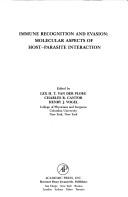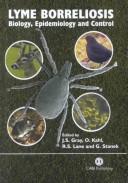| Listing 1 - 10 of 21 | << page >> |
Sort by
|
Book
ISBN: 0854033831 Year: 1989 Publisher: London : Royal society,
Abstract | Keywords | Export | Availability | Bookmark
 Loading...
Loading...Choose an application
- Reference Manager
- EndNote
- RefWorks (Direct export to RefWorks)
Antigenic determinants --- Immune recognition --- Proteins --- Congresses. --- Congresses. --- Immunology --- Congresses.

ISBN: 0125978502 Year: 1975 Publisher: New York (N.Y.): Academic press
Abstract | Keywords | Export | Availability | Bookmark
 Loading...
Loading...Choose an application
- Reference Manager
- EndNote
- RefWorks (Direct export to RefWorks)
Cellular recognition --- Immune recognition --- Immunity, Cellular --- Leukocytes --- Lymphocyte Activation --- Lymphocytes --- Congresses

ISBN: 0127117105 Year: 1990 Publisher: San Diego Boston Toronto Academic Press
Abstract | Keywords | Export | Availability | Bookmark
 Loading...
Loading...Choose an application
- Reference Manager
- EndNote
- RefWorks (Direct export to RefWorks)
Book
ISBN: 1852210621 9781852210625 Year: 1988 Publisher: Oxford : IRL Press,
Abstract | Keywords | Export | Availability | Bookmark
 Loading...
Loading...Choose an application
- Reference Manager
- EndNote
- RefWorks (Direct export to RefWorks)
B Lymphocytes --- Receptors, Antigen --- T Lymphocytes --- immunology --- Immune recognition --- B-Lymphocytes --- Antigen recognition --- Immunorecognition --- Recognition, Immune --- Immunospecificity --- Immune recognition. --- Immunology --- T-Lymphocytes --- #ABIB:aimm --- Immune response --- immunology. --- T-Lymphocytes - immunology --- Receptors, Antigen - immunology --- B-Lymphocytes - immunology

ISBN: 0851991254 Year: 1996 Publisher: Wallingford CAB International
Abstract | Keywords | Export | Availability | Bookmark
 Loading...
Loading...Choose an application
- Reference Manager
- EndNote
- RefWorks (Direct export to RefWorks)
Arthropods --- Arthropod vectors. --- Host-parasite relationships --- Immune recognition. --- Immunological aspects. --- ARTHROPODS --- SCABIES --- MITES --- CULICIDAE --- DIPTERA --- FLEAS --- LICE --- TICKS --- ANATOMY AND HISTOLOGY --- IMMUNOLOGY --- PATHOGENICITY
Book
ISBN: 282189497X 2760625826 2760621960 2711683974 9782760621961 9782711683970 2760630692 Year: 2010 Publisher: Presses de l’Université de Montréal
Abstract | Keywords | Export | Availability | Bookmark
 Loading...
Loading...Choose an application
- Reference Manager
- EndNote
- RefWorks (Direct export to RefWorks)
Quel est le lien entre immunologie et identité ? Au cœur de l’immunologie se trouvent les concepts de « soi » et de « non-soi », ainsi que ceux d’unicité et d’individualité. Les immunologistes contemporains affirment que, en se fondant sur le vocabulaire du soi et du non-soi, leur discipline apporte une réponse à la question de savoir ce qui fait l’identité d’un organisme à travers le temps. Cet ouvrage met en doute cette affirmation. S’appuyant sur des données récentes sur la tolérance immunitaire, le chimérisme ou encore la symbiose, il montre que la théorie du soi et du non-soi, qui domine l’immunologie depuis plus de cinquante ans, n’est plus adéquate. Il propose une autre théorie, la théorie de la continuité, dont l’un des objectifs est de rendre compte des nombreux cas dans lesquels un organisme tolère des entités étrangères, en particulier des bactéries. L’organisme doit alors être compris selon une perspective écologique : il est ouvert à l’extériorité, à l’autre, et en grande partie constitué par l’appropriation d’entités initialement « étrangères ». L’immunologie donne bien une définition de l’identité biologique, mais celle-ci est aux antipodes de la conception selon laquelle l’organisme serait une réalité fermée, définie de façon endogène et défendant son intégrité contre tout « non-soi ».
Spécificité (Immunologie) --- Immunologie. --- Immunité. --- Immunospecificity. --- Immunology. --- Immunity. --- Immunobiology --- Immunological specifics --- Serological specificity --- Specificity (Immunology) --- Life sciences --- Serology --- Antibody diversity --- Antigenic determinants --- Binding sites (Biochemistry) --- Immune recognition --- Immunology --- organisme --- immunité --- immunologie --- philosophie du vivant --- Biologie --- Immunologie --- Philosophie
Book
ISBN: 1493999281 149399929X Year: 2020 Publisher: New York, NY : Springer US : Imprint: Humana,
Abstract | Keywords | Export | Availability | Bookmark
 Loading...
Loading...Choose an application
- Reference Manager
- EndNote
- RefWorks (Direct export to RefWorks)
This volume looks at key methodologies that are commonly used across antibody drug conjugates (ADCs) programs. The chapters in this book cover topics such as conjugations to endogenous cysteine residues; click chemistry conjugations; antibody conjugations via glycosyl remodeling; analysis of ADCs by native mass spectrometry; characterization of ADCs by capillary electrophoresis; LC/MS methods for studying lysosomal ADC catabolism; and determination of ADC concentration by ligand-binding assays. Written in the highly successful Methods in Molecular Biology series format, chapters include introductions to their respective topics, lists of the necessary materials and reagents, step-by-step, readily reproducible laboratory protocols, and tips on troubleshooting and avoiding known pitfalls. Cutting-edge and practical, Antibody-Drug Conjugates: Methods and Protocols is a valuable resource that aims to lower the “activation barrier” when undertaking a new discipline, and provides a “toolbox” for the next generation of ADC scientists.
Immunospecificity. --- Pharmacology. --- Adaptive Immunity. --- Drug effects --- Medical pharmacology --- Medical sciences --- Chemicals --- Chemotherapy --- Drugs --- Pharmacy --- Immunological specifics --- Serological specificity --- Specificity (Immunology) --- Antibody diversity --- Antigenic determinants --- Binding sites (Biochemistry) --- Immune recognition --- Physiological effect
Book
ISBN: 1441909001 9786612824920 144190901X 1282824929 Year: 2009 Publisher: New York, NY : Springer New York : Imprint: Springer,
Abstract | Keywords | Export | Availability | Bookmark
 Loading...
Loading...Choose an application
- Reference Manager
- EndNote
- RefWorks (Direct export to RefWorks)
Target pattern recognition in innate immunity is responsible for the immediate, usually protective, responses shown against invading microorganisms, and it is the principal feature of self and non-self recognition by virtue of the recognition of structures on the microbial pathogens, which are not found on host cells. This is an area that has been very actively researched, over approximately the past 12 years, and therefore this volume provides a timely comprehensive, and up to date, summary of the types and range of cell surface, intracellular, and secreted, host proteins involved in the recognition of microbial products, and of the protective mechanisms triggered as a result of the recognition events. The Toll-like receptors, first described in Drosophila and now well-characterised on human cells, provide an excellent demonstration of the wide range of different microbial products recognised by this family of receptors and of the signalling pathways which are triggered thus leading to induction of inflammatory cytokines and the activation of genes producing antimicrobial products. In addition, several cell surface proteins involved in target pattern recognition have been described on the surfaces of macrophages (macrophage mannose receptor and macrophage scavenger receptors), and on dendritic cells (DEC205), and to be involved with the uptake and clearance of whole microorganisms and polyanioic ligands. Pattern recognition is also utilised by intracellular receptors, with NOD-like receptors in the cytosol recognizing microbial molecules and activating the production of inflammatory cytokines or pathways that induce the production of inflammatory molecules. Secreted proteins, such as the pentraxins, which includes the acute phase reacting, C-reactive protein (CRP) and serum amyloid protein (SAP), and the collectins (mannan binding lectin, lung surfactant protein A and D) and ficolins can also readily recruit killing and clearance systems. Indeed, the serum complement system, which is one of the major defence systems in the bloodstream, is efficiently activated by CR P on its binding to the phosphocholine groups of microbial phospholipids—and the subsequent interaction of the bound CR P with C1q—to give classical pathway activation, or MBL, or ficolin, binding to arrays of mannose or N-acetyl-glucosamine residues, respectively, on the surfaces of microorganisms—to give lectin pathway activation. Also, in addition to the activation and clearance events associated with complement activation by some of the secreted pattern recognition receptors, it is accepted that all these pattern recognition receptors can generally accelerate the uptake and clearance of microbes via phagocytic cells. In view of the growing interest in the cross-talk between innate and adaptive immunity, a thorough understanding of the initial recognition and triggering events, mediated via innate immune receptors, as addressed in this volume, is clearly very useful in helping to also fully understand the mechanisms of activation and control of the adaptive immune system—and to allow a full assessment of the relative roles played by innate immunity and adaptive immunity against a particular infection in higher organisms.
Gene Targeting. --- Immune recognition. --- Immunity, Innate -- genetics. --- Natural immunity. --- Immune recognition --- Natural immunity --- Immunity, Innate --- Genetics --- Gene Targeting --- Biology --- Genetic Techniques --- Immunity --- Immune System Phenomena --- Biological Science Disciplines --- Investigative Techniques --- Natural Science Disciplines --- Analytical, Diagnostic and Therapeutic Techniques and Equipment --- Phenomena and Processes --- Disciplines and Occupations --- Medical Research --- Microbiology & Immunology --- Medicine --- Health & Biological Sciences --- Disease resistance --- Host resistance --- Innate immunity --- Innate resistance --- Native immunity --- Natural resistance --- Nonspecific immunity --- Resistance to disease --- Antigen recognition --- Immunorecognition --- Recognition, Immune --- Medicine. --- Immunology. --- Biomedicine. --- Biomedicine general. --- Immunobiology --- Life sciences --- Serology --- Clinical sciences --- Medical profession --- Human biology --- Medical sciences --- Pathology --- Physicians --- Immune response --- Immunospecificity --- Health Workforce --- Biomedicine, general.
Book
ISBN: 1071621157 1071621149 Year: 2022 Publisher: New York, NY Springer Nature
Abstract | Keywords | Export | Availability | Bookmark
 Loading...
Loading...Choose an application
- Reference Manager
- EndNote
- RefWorks (Direct export to RefWorks)
This open access book explores techniques for working in the field of immunogenetics, i.e. fundamental and translational research into the adaptive immune receptor repertoire. Many chapters are dedicated to lab protocols, bioinformatics, and immunoinformatics analysis of high-resolution immunome analysis, exemplified by numerous applications. Additionally, the newest technological variations on these protocols are discussed, including non-amplicon, single-cell, and cell-free strategies. Written for the highly successful Methods in Molecular Biology series, chapters include introductions to their respective topics, lists of the necessary materials and reagents, step-by-step, readily reproducible laboratory protocols, and tips on troubleshooting and avoiding known pitfalls. Authoritative and practical, Immunogenetics: Methods and Protocols covers a broad spectrum of methodologies for applications in research and clinical diagnostics to illustrate the impact that immunogenetics has achieved and will further expand in all fields of medicine, from infection and (auto)immunity, to vaccination, to lymphoid malignancy and tumor immunity.
Immunogenetics. --- Immunospecificity. --- Adaptive Immunity. --- Immunological specifics --- Serological specificity --- Specificity (Immunology) --- Antibody diversity --- Antigenic determinants --- Binding sites (Biochemistry) --- Immune recognition --- Genetics --- Immunity --- Immunology --- Serology --- Immunological aspects --- Genetic aspects --- The immunome --- Adaptive immune cells --- Antigen receptors --- Immunoinformatics --- T-cell receptors --- Lymphocytes --- Immunogenètica --- Receptors cel·lulars --- Manuals de laboratori
Periodical
ISSN: 17534267 17534259
Abstract | Keywords | Export | Availability | Bookmark
 Loading...
Loading...Choose an application
- Reference Manager
- EndNote
- RefWorks (Direct export to RefWorks)
Endotoxins --- Endotoxins. --- Immunity, Natural. --- Endotoxines --- Immunity, Innate. --- Innate Immune Response --- Innate Immunity --- Immunity, Native --- Immunity, Natural --- Immunity, Non-Specific --- Resistance, Natural --- Immune Response, Innate --- Immune Responses, Innate --- Immunity, Non Specific --- Innate Immune Responses --- Native Immunity --- Natural Immunity --- Natural Resistance --- Non-Specific Immunity --- Bacterial pyrogens --- Endotoxin --- Lipopolysaccharides, Microbial --- Microbial lipopolysaccharides --- Bacterial cell walls --- Bacterial toxins --- Gram-negative bacteria --- Microbial lipids --- Microbial polysaccharides --- Pyrogens --- Receptors, Pattern Recognition --- Adaptive Immunity --- Inflammasomes --- Immunity, Innate --- Inflammation --- Health Sciences --- Physiology --- immunology --- immune recognition --- immune response --- endotoxins --- innate immunity
| Listing 1 - 10 of 21 | << page >> |
Sort by
|

 Search
Search Feedback
Feedback About UniCat
About UniCat  Help
Help News
News